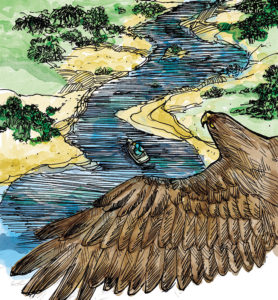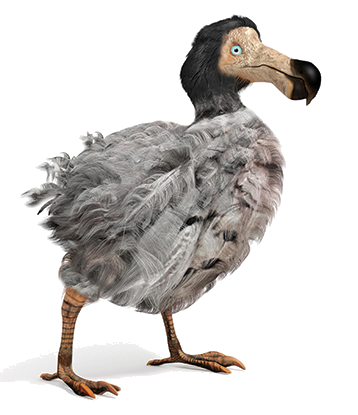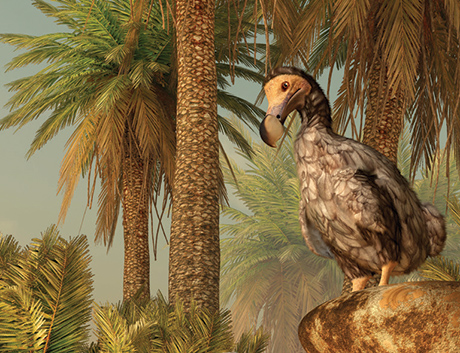Raph’s Tale, A Fable About Neurodiversity
Dan Shapiro
Attention Magazine October 2021
Download PDF
Text by Dan Shapiro, MD; illustrations by John Watkins-Chow*
 Hawk soared high over the river. Down below, he saw a little boat with a funny-looking bird. It was drifting downstream, toward Great Falls. Hawk flew down and perched on the boat. Hawk screeched, “You’re going to kill yourself staying in that tiny tub! Fly away, you stupid bird!”
Hawk soared high over the river. Down below, he saw a little boat with a funny-looking bird. It was drifting downstream, toward Great Falls. Hawk flew down and perched on the boat. Hawk screeched, “You’re going to kill yourself staying in that tiny tub! Fly away, you stupid bird!”
But the strange bird just stood there in its boat and said, “I would if I could.”
Hawk couldn’t believe it: “What kind of bird doesn’t even know how to fly?”
The odd bird answered, “Raphus cucullatus, of course. You can call me Raph.” Then Raph added, “I want Tambalacoque.”
Well, Hawk had never heard of a Raphus cucullatus bird—or Tambalacoque. All Hawk knew was that Raph was soon to be a goner. Great Falls was roaring louder and louder. Hawk grabbed Raph in his talons and flapped his wings—hard. Hawk didn’t get twenty feet before realizing that Raph was just too heavy. So Hawk dropped Raph back on the boat and thought, “Not much more I can do here.”
Hawk started to fly away, but Raph called out, “I want Tambalacoque.”

Hawk muttered, “What am I getting myself into?” Hawk sighed, swooped back down, and perched on the back of the boat. Hawk’s talons dug deep into the stern. Hawk’s wings flapped hard. The little boat moved up the river, far away from the falls. Raph was safe, but Hawk was exhausted. No way could Hawk push Raph’s boat all the way up the river. What to do?
Just then, for no good reason, Raph said, “I want to go back down the river.”
Hawk said, “Remember Great Falls. Raph, you need to go up the river!”
Raph said, “No, I don’t. I don’t care about Great Falls!”
Hawk yelled, “You have to do as I say!”
Again, Raph yelled back, “No, I don’t!”
Back and forth they fought. The little boat rocked from side to side. Before they knew it, they’d thrown each other overboard. Underwater, they struggled to breathe—but they kept on fighting.
Finally, the fight ended. Maybe Hawk won the fight. Or maybe Hawk just gave up. Who can remember? And what did it matter? Raph and Hawk drifted backward in the cold water. The boat drifted beside them. The sound of Great Falls was getting even louder. Somehow, Hawk and Raph dragged themselves back onto the boat. Hawk flapped and pushed the boat ashore, safe once more. Staying at different ends of the boat, not saying a word, they caught their breath. Just then, a round fruit fell out of a tree and into the boat.
Raph cried, “Tambalacoque!” and ate it with one joyful gulp.
Hawk smiled and said to himself, “So that’s what Tambalacoque is.” At that moment, Hawk knew they were in this boat together.
As they fell asleep, exhausted, Hawk wondered, What kind of bird is this anyhow?
Mile by mile, in sputters and spurts, they continued their journey. On good days, when there was a strong wind at their backs, they hoisted sail and spread their wings. Hawk’s wings were so big. Raph’s wings were so little. Raph knew, I can’t fly like other birds. But when they caught the wind just right, Raph felt like their boat could fly!
NEURODIVERSITY LIVES
Decade by decade, more children are being identified with all types of developmental disabilities. Many complicated factors account for this rise. Much of the increase is because of broader diagnostic categories, better identification, and heightened sensitivity. Children with special needs have always been around. But they have been hidden from view in basements, institutions, and prisons, or otherwise marginalized by blame, shame, and derogatory names. Relatively “flightless” but completely innocent, they are not “dodos.” They are our children. They are us. And we are all in the same boat together. With limited resources, our crisis—our challenge—is how to provide services, education, and jobs for the growing number of children and adults with special needs.
Despite this crisis—perhaps because of it—the twenty-first century has become a much more hopeful time to have a child with developmental differences. These children are finally getting recognition and help. The Americans with Disabilities Act prohibits discrimination against individuals with disabilities. The Individuals with Disabilities Education Act guarantees early intervention, special education, and related services to infants, children, and adolescents with disabilities. The disability rights and inclusion movements grow stronger every year. A powerful army of parents, providers, educators, and researchers have spearheaded a truly revolutionary change in sensitivity, expertise, and advocacy. Brain science and developmental practice continue to advance at an extraordinary pace. There is a growing awareness of the need to keep neurodiversity alive. We are only as great as our compassion for one another, not despite but because of our wonderful differences.
History of Raphus cucullatus
In the Indian Ocean, off the southeast coast of Africa, is a huge island called Madagascar. Just a bit farther east is a tiny island called Mauritius. There, in the woods near the water, lived a bird named Raphus cucullatus; or for short, as affectionately nicknamed in this book, Raph. This bird was descended from a proud old family of pigeons and doves. But in many ways, Raph was a bird of a different feather.
Raph was a big bird, standing more than three feet tall and weighing more than thirty pounds. Raph had brown-gray feathers all over its body, a little extra tuft of feathers for a tail, but no feathers at all on its head. In fact, Raph’s last name, cucullatus, means “wearing a hood.” Raph’s beak was very large: black, yellow, and red, with a huge bulb for smelling. Like a turkey, Raph kept rocks in its gizzard for grinding up swallowed food. Raph’s wings were too weak to fly. But with big yellow feet and strong sturdy legs, Raph could walk around just fine. And there was plenty of ground food, mostly nuts and fruits.
Raph’s favorite fruit was the Tambalacoque, a round, juicy kind of peach with a woody pit containing its seeds. Raph enjoyed picking up Tambalacoque fruit with its beak and grinding up the pit with stones in its gizzard.
On the little island of Mauritius, Raph had plenty of friends and no enemies. With nothing to fear, there was no need to fly. Raph only needed to lay one egg at a time to ensure its family’s survival.
Even if Raph was a different kind of bird, Mauritius suited Raph just fine. And in one very special way, Raph suited the island of Mauritius.
Not only did Raph get big eating Tambalacoque fruit, the Tambalacoque tree flourished thanks to Raph. Each time Raph ate Tambalacoque fruit, seeds germinated in Raph’s intestines. With each poop, Raph disseminated Tambalacoque seeds. The more Tambalacoque fruit Raph ate, the more Tambalacoque seeds were planted. A win-win, bird-tree relationship! Talk about recycling! Propagation through defecation!
For thousands of years, there were no human beings on the island of Mauritius. But then, starting in the 1500s, Portuguese explorers made occasional visits. The Raphinae family’s first sustained encounters with people were not until about 1600, when Dutch sailors came to Mauritius. They had never seen birds like Raph. These birds didn’t know flight or fear. They were defenseless and naive. The Dutch easily killed them, ate them, and destroyed their habitat. The Dutch boats also brought cats, rats, pigs, and monkeys. These nonnative animals ate the Raphinae family’s eggs. Extinction came quickly.
 This strange bird is now known as the “dodo.” It’s not clear how such a derogatory name originated. The most generous explanation is that “dodo” might have been an approximation of the bird’s call, a two-note pigeon-like sound, “doo-doo.” More likely, and still not so bad, “dodo” might have been a term related to the Dutch word Dodaars, which means either “fat-arse” or “knot-arse,” referring to the tuft of feathers on its hind end. But because these flightless and fearless birds were so easily caught, it’s likely that “dodo” came from the Dutch word dodoor for “sluggard” or the Portuguese word doudo (currently doido), meaning “fool” or “crazy.” Despite this uncertainty about origins, everybody today knows to “go the way of the dodo” means to be “dead as a dodo” because you clearly must have been “stupid as a dodo.”
This strange bird is now known as the “dodo.” It’s not clear how such a derogatory name originated. The most generous explanation is that “dodo” might have been an approximation of the bird’s call, a two-note pigeon-like sound, “doo-doo.” More likely, and still not so bad, “dodo” might have been a term related to the Dutch word Dodaars, which means either “fat-arse” or “knot-arse,” referring to the tuft of feathers on its hind end. But because these flightless and fearless birds were so easily caught, it’s likely that “dodo” came from the Dutch word dodoor for “sluggard” or the Portuguese word doudo (currently doido), meaning “fool” or “crazy.” Despite this uncertainty about origins, everybody today knows to “go the way of the dodo” means to be “dead as a dodo” because you clearly must have been “stupid as a dodo.”
The last living bird from the Raphinae family was seen in 1662. But the name “dodo”—and a very important message—lives on.
History of the Tambalacoque Tree

Sideroxylon grandiflorum, known as the Tambalacoque tree, is endemic to the island of Mauritius. It is a majestic tree with many strong roots and sprawling, thick branches that provide plenty of shade. Each tree normally lives for hundreds of years.
As you have already read, the Raphinae family needed the Tambalacoque tree for food, and the tree needed the bird to be its “Johnny Appleseed.” Up through its extinction in the seventeenth century, Raphinae ate the Tambalacoque fruit and spread the seeds. Because of this mutually beneficial relationship, the Tambalacoque became known as the “dodo tree.” But if so linked in life, what would keep the “dodo” and “dodo tree” from being likewise linked in death? Was the Tambalacoque tree too dependent on the Raphinae?
Over the centuries, since the last of the Raphinae died, there has been a steady decline in the number of Tambalacoque trees. But this sad story has a hopeful epilogue. Ironically, the rapid extinction of the Raphinae helped inspire the wildlife conservation movement. Raphus became a powerful early “poster bird” for protection of other endangered species. Locally, alarmed by the dodo bird’s fate, Mauritians devoted themselves to saving its namesake tree. Globally, recognition of the bird and tree’s mutual decline served as a cautionary tale about the interconnection of all life. To whatever degree Raph’s extinction endangered the Tambalacoque, their relationship shed light on the importance of protecting individual species for the sake of entire ecosystems.
The seventeenth century was a terrible time to be a flightless bird. There were no conservationists around to save the Raphinae. But their extinction made the twenty-first century a more encouraging time for the Tambalacoque tree. Legions now rally to protect the Tambalacoque tree and the diversity of all natural life. One can only wonder: What if Raph was alive today? Would it be listed as an endangered species? Would hunting be illegal? Would people defend its habitat? Moreover, would it still be called a dodo bird?
* Excerpted by permission from Raph’s Tale, copyright @ 2020 by Dan Shapiro, MD, and published by Dagmar Miura; available on Amazon.com.
 Dan Shapiro, MD, is a developmental-behavioral pediatrician in Rockville, Maryland. He developed ParentChildJourney.com, a comprehensive set of parent training and support programs. He is a fellow of the American Academy of Pediatrics and a member of the Society for Developmental and Behavioral Pediatrics. In addition to Raph’s Tale and multiple articles, he is the author of Parent Child Journey: An Individualized Approach to Raising Your Challenging Child and Parent Child Excursions: ADHD, Anxiety and Autism.
Dan Shapiro, MD, is a developmental-behavioral pediatrician in Rockville, Maryland. He developed ParentChildJourney.com, a comprehensive set of parent training and support programs. He is a fellow of the American Academy of Pediatrics and a member of the Society for Developmental and Behavioral Pediatrics. In addition to Raph’s Tale and multiple articles, he is the author of Parent Child Journey: An Individualized Approach to Raising Your Challenging Child and Parent Child Excursions: ADHD, Anxiety and Autism.
John Watkins-Chow illustrated all three of Dr. Shapiro’s books. He teaches math at a private school in suburban Maryland.
Other Articles in this Edition
Resilience and ADHD During the Pandemic
Challenges in ADHD Care for Children of Color
PART ONE
Pay ADDention™! I’m a Teen Expert on ADD
Study Skills for Thriving with ADHD
Raph’s Tale, A Fable About Neurodiversity
Black Adults Who Live with ADHD
